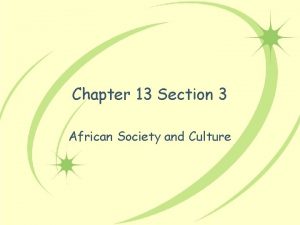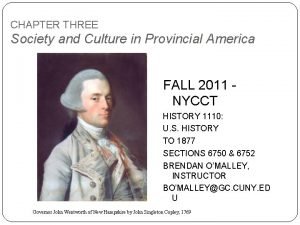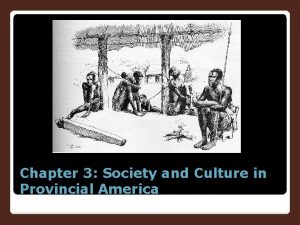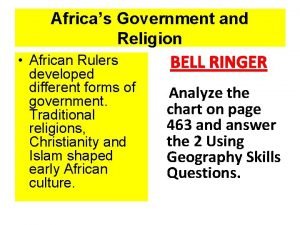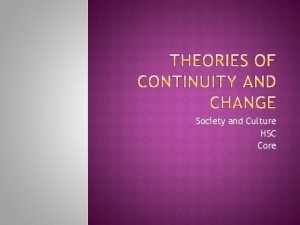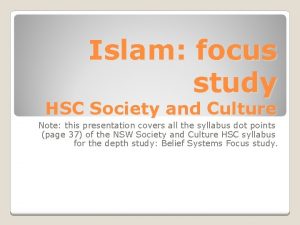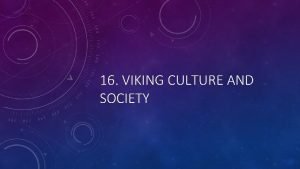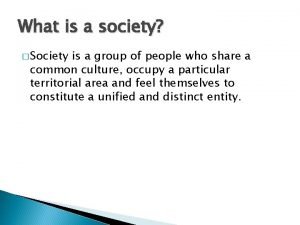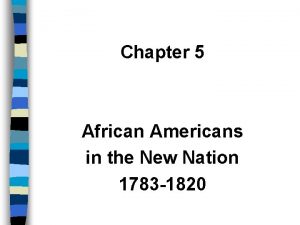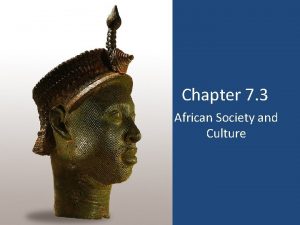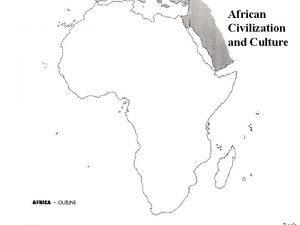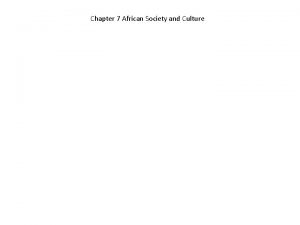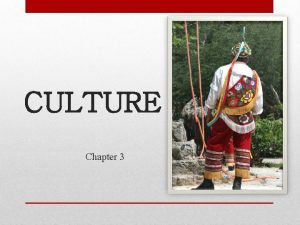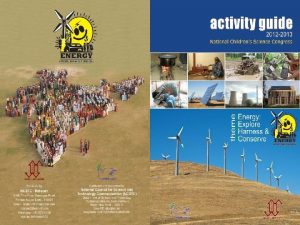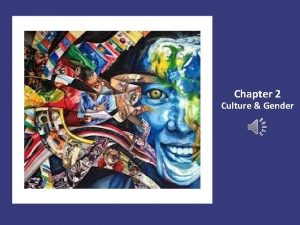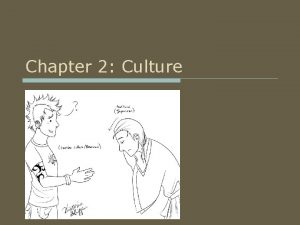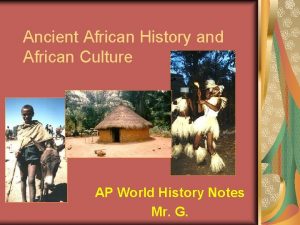African Culture Chapter 3 I African Society and





















































- Slides: 53

African Culture Chapter 3

I. African Society and Culture • The family was the basis of Africa society. • Lived in extended families, or families made up of several generations. • Matrilineal societies that traced their descent through their mothers rather than fathers.

A. Education • Children learned the history of their people and skills they needed from their family and the village. • Griots, or storytellers kept alive their village’s oral history through stories passed down by word of mouth.

Religions of Africa 46% Christian 40% Muslim 12% Traditional African Religions

B. Traditional African Religions • Varied from region to region. • Most believed in one Creator. • Provided rules for living and helped people stay in touch with their history. • Believed that spirits of the dead stayed with the community. • They believed these spirits could talk to God and could help solve problems.

C. Women’s Roles • Women were mostly mothers and wives. • Men had more rights and controlled much of what women did. • In some African kingdoms women served as soldiers. • Some women were famed rulers: 1. Queen Dahia al-Kahina led a fights against Muslim take over of her kingdom in 600 A. D. (modern day Mauritania) 2. Queen Nzinga spent 40 years battling Portuguese slave traders. (she ruled where modern day Angola and Congo is)

D. African Art and Dance • Masks and statues were made to celebrate African religious beliefs. • Artist worked in wood, ivory, or bronze to show faces of important leaders. • Music and dance allowed them to express themselves and to celebrate important events such as birth and death.

http: //www. hp. uab. edu/image_archive/um/painting 06. jpg

I. Who were the Bantu • 3000 B. C. fishing groups along the Benue River packed their belongings and began moving throughout Africa. • The wonders called themselves “Bantu” meaning “wonderers. ” • They spread throughout Africa bringing their culture. • 120 million Africans speak hundreds of Bantu languages

II. Trade Caravans Begin • The vast Sahara kept the Bantu from migrated to Northern Africa. • For 1, 000 of years the North was isolated until 400 B. C. the North African Berbers found a way across the Sahara to West Africa, and trade began. • Romans introduced camels to N. Africa-this revolutionized trade.


I. Ghana • The first empire to develop in West Africa in 400 A. D. • Ghana was located where several trade routs came together-anyone who wanted to used these trade routes had to pay a fee-this made Ghana rich. • Ghana made weapons of iron and controlled people who had gold mines.

A. Ghana’s Government • King relied on a council of ministers • As the empire grew-divided empires into provinces-lesser kings governed these. • King held power tightly • Local rulers had to send their sons to the royal courts. • Nobody could trade without the permission of the king. • Nobody could own gold nuggets except the king. • People had to trade in gold dust. • The kingdom was inherited only by the son of the king’s sister.

B. The Fall of Ghana • Their power declined when gold mines outside Ghana’s control reduced the taxes it collected. • Heavy farming depleted the minerals and made it harder to grow enough crops. • Constant warfare • Rulers accepted Islam • In 1200’s the kingdom of Mali conquered what was left of the empire.

Ghana developed in West Africa between the Niger (NI-jhur) and the Gambia Rivers. It was an important kingdom there from about AD 300 to about 1100. The rivers helped Ghana to grow rich because they were used to transport goods and develop trade. Ghana also collected taxes from traders who passed through the kingdom. The people called their nation Wagadu; we know it as Ghana --that was the word for war chief. http: //www. nevadasurveyor. com/africa/web/pages/niger_river. htm


The kingdom of Ghana probably began when several clans of the Soninke people of west Africa came together under the leadership of a great king named Dinga Cisse. Ghana had few natural resources except salt and gold. They were also very good at making things from iron. Ghanaian warriors used iron tipped spears to subdue their neighbors, who fought with weapons made of stone, bone, and wood. http: //www. imf. org/external/np/exr/center/mm/eng/mm_rs_01. htm

"The King. . . (wears). . . necklaces round his neck and bracelets on his forearms and he puts on a high cap decorated with gold and wrapped in a turban of fine cotton. He (meets people) in a domed pavilion around which stand ten horses covered with gold-embroidered materials…and on his right, are the sons of the (lesser) kings of his country, wearing splendid garments and their hair plaited with gold. At the door of the pavilion are dogs of excellent pedigree. Round their necks they wear collars of gold and silver, studded with a number of balls of the same metals. " 10 th century geographer Al-Bakri, quoted in Corpus of Early Arabic Sources for West African History. This is a primary source that describes the court of one king of Ghana. Complete the worksheet on the modified reading.

Ghana became a rich and powerful nation, especially when the camel began to be used as a source of transport. Ghana relied on trade and trade was made faster and bigger with the use of the camel. http: //es. encarta. msn. com/media_461532998_761558787_-1_1/Caravana_de_camellos. html news. nationalgeographic. com/. . . /salt/photo 6. html Click here to learn about camels. Use your notetaking sheet to record your answers.

Islamic Mosque in Ghana blankbluesky. com/ travel/ghana/ After 700 AD, the religion of Islam began to spread over northern Africa. Followers of this religion are called Muslims. Muslim warriors came into Ghana and fought with the non-Islamic people there. This weakened the great civilization of Ghana. Local warriors then decided to break away from the power of Ghana and form their own local kingdoms. This ended many of the trade networks. This eventually weakened the civilization of Ancient Ghana. Return

http: //www. btsadventures. com/img/mosque. jpg

I. Mali • 1230 to 1255 the great warrior king Sundiata Keita “the Lion Prince” conquered Ghana. • Seized the capital of Ghana in 1240. • He controlled lands from the Atlantic coast to the trading city of Timbuktu. • He was able to rebuild the gold and salt trade.

A. Mansa Musa • Leader of Mali who used the wealth of Mali to build mosques and libraries to collect books from all over the Muslim world. • 1324 Mansa Musa makes a famous pilgrimage to Mecca. • While in Mecca, convinced some of Islam’s finest architects, teachers, and writers, to accompany him back to Mail-this helped spread Islam in West Africa. • After Mansa Musa’s death in 1332 the kings that failed to stop Berber invaders who conquered Timbuktu.

B. The Griots This is a 19 th century griot of Mali with his instrument • Storytellers were called Griots or djeli • They were important people in Mali • They told the land’s history • Most of what we know about ancient Mali came from the storytellers • They were advisors to the kings

C. Why was Salt Important? The man is holding a slab of salt mined recently near Timbuktu Mini. Fact: The picture behind these words is also a slab of SALT! • Mali often traded its gold for salt • Salt was sometimes more valuable than gold! • People’s bodies need salt to live – In the desert heat, salt is lost through perspiration • Salt was used to preserve food • Salt was brought in large slabs (coins)

D. Timbuktu • A very important city in Mali – Center of learning for Muslims – Universities and schools – Largest trading center in Mali – On the Niger River • Trade • Food • Washing Timbuktu 19 th century traders in Timbuktu

A powerful king named Sundiata ruled this area from around 1230 -1255 AD. He led the people in conquering and expanding his kingdom to be as great as Ghana had been. Perhaps the greatest king of Mali was Mansa Musa (1312 -1337). He developed the gold and salt trade of Mali and his kingdom became very powerful and rich. Mansu Musa: Lord of the Negroes of Guinea. (Photo courtesy of History of Africa)

Mansa Musa was a Muslim, meaning he followed the religion of Islam. He built many beautiful mosques or Islamic temples in western Africa. http: //travel. u. nu/pic/ml/djenne. jpg

A Muslim church is called a Mosque This is the mosque at Djenne in Mali. It’s built of mud! Click for a movie


In 1324 Mansa Musa made a pilgrimage ( a journey to a holy place) to Mecca, which is a holy city in Arabia, with 60, 000 servants and followers and 80 camels carrying more than 4, 000 pounds of gold to be distributed among the poor. Of the 12, 000 servants 500 carried a staff of pure gold. This showed his power and wealth to the other people he visited. http: //bseleck. bei. t-online. de/timbuktu/img_tim/mansamusag. gif

What did Mali trade? • Gold The dotted lines are trade routes from Mali to other parts of Africa

What else did they trade? Camels, the ships of the desert, traveled in caravans bringing to Mali: • • Salt Copper Ivory Cloth • • Kola Nuts Slaves Books Shells Mini. Fact: This was before Columbus even sailed to the New World!

When Mansa Musa died there were no kings as powerful as he was to follow. The great kingdom of Mali weakened. Eventually a group of people known as Berbers came into the area and other people came up from the south to claim territory that was once part of the kingdom. Although Mali fell, another advanced African kingdom took its place, the kingdom of Songhai. The Berbers still live in North Africa. This picture, taken in 1893, shows a Berber group. http: //www. uchicago. edu/docs/mp-site/plaisanceplan/graphics/berbers. jpg

Mali Today

http: //www. exzooberance. com

I. Songhai • In 1468 Sunni Ali took back Timbuktu and drove out the Berbers. • He swept throughout western Africa and took Berber salt mines. • He declared himself Muslim to keep the support of the townspeople. • By his death in 1492 -he has built the largest empire in Western Africa.

A. Songhai and Askia Muhammad • Sunni Ali’s son refused to follow his father’s example. • Sunni Ali’s general, Muhammad Ture, saw a chance to take over the government. • With the support of the townspeople he drove out Sunni Ali’s family and made himself leaderrenamed Askia Muhammad. • Built the largest empire in medieval West Africa. • Made Timbuktu an important center of Islamic culture with a university and set up some 150 schools to teach the Quran.

B. The End of Songhai • Lasted for 100 years-was conquered in 1591 by a small army from the Arab kingdom of Morocco crossed the Sahara. • Soldiers with cannons and guns easily cut down Songhai soldiers armed with swords, spears, and bows.

This map was created in 1375. The same trade routes were used by the merchants of the Songhai kingdom. What kinds of pictures do you see on the map and why do you think the mapmaker put them there? http: //www. sfusd. k 12. ca. us/schwww/sch 618/Travelers/Catal_Atlas. Africa. jpg

The picture above is one artist’s idea of what the great Songhai leader, Sunni Ali might have looked like. Sunni Ali saw that the kingdom of Mali was weakening and he led his soldiers to conquer the area. He began the kingdom of Songhai. He also set up a complex government to rule all the lands he had conquered. http: //www. abcorpaffairs. com/gallery/

All three kingdoms of West Africa relied on trade for their strength and wealth. Look at the map at complete the “In and Out of Africa” worksheet in your packet. Silk, Ceramics, Beads, Islam from Europe and Asia Salt Timbuktu Gao Jenne Gold, Ivory, Wood, Slaves Coming into West Africa Coming from Africa and going to Europe and Asia

Click here to complete a scavenger hunt about western Africa. Use the “Scavenger Hunt” worksheet in your packet. http: //www. africanculturalcenter. org/4_4 tradekingdoms. html#

Sunni Ali died in 1492 CE. His son took over the rule of Songhai but he did not accept Islam as a religion. Islam was accepted as a religion by many people in northern Africa. One of Sunni Ali’s generals, named Muhammad Ture, overthrew the new king and made himself king of Songhai. Ture was a follower of Islam (Muslim) and so he made Islam the religion of his kingdom. This is a photo of a mosque, or place of worship for Muslims, in western Africa. Many mosques were built of local materials. http: //www. thewoz. ca/ghana/_larabanga 1. jpg

For more detailed information on Songhai, click on the picture. Songhai remained a rich and strong kingdom under Muhammad Ture’s rule. It had a complex government centered in the city of Gao, and great centers of learning. But later rulers were not as powerful. In the late 1500 s, Morocco invaded Songhai to take its rich trade routes. Moroccans had a new weapon, the gun, and the army of Songhai did not. This led to the fall of Songhai. (Photo courtesy of African Origin of Civilization by Cheikh Anta Diop)


The Great Zimbabwe is huge stone structure in the modern nation of Zimbabwe. This 800 foot long structure has outer walls 32 feet high and 17 feet think in some places. It was probably started around 1200 C. E. IT is thought that the Great Zimbabwe was a religious, governmental, and ceremonial center for the Bantuspeaking Shona people: as many as 20, 000 people lived around it. The Portuguese were sure that it was built b y the Queen of Sheba. Other people felt it was built by Egyptians, Greeks, or even aliens from out space. What YOU think?

South African Civilizations Zimbabwe on the Zambezi (River) • located on the grasslands between the Zambezi and Limpopo Rivers • 1871 - German explorer Karl Mauch found the remains of a powerful and prosperous civilization • city (10, 000) wall of cement and stone 38 feet high • found ornaments of gold, copper, porcelain from China • wealth source- tax on cattle and gold trade • German Mauch- did not give credit to Africans- prejudice • historians recognize and give credit to Africans.



I. The Development of Slavery • Slavery already existed throughout the world including in Africa. • Bantu chiefs would raid nearby villages and would take captives which became laborers or were released for a fee. • Criminals and prisoners of war also became slaves. • Slaves in Africa could win their freedom through work or by marrying a free person.

II. Slavery in Africa • Muslims owned traded slaves-had to be non-Muslims. • Began in Europe in 1441 with the Portuguese. • Mostly used on Portuguese plantations because of their farming skills and ability to make tools. • By late 1400’s other European countries began to enslave Africans.

 West african society and culture section 3
West african society and culture section 3 Lesson 5 african american culture and politics
Lesson 5 african american culture and politics Chapter 3 society and culture in provincial america notes
Chapter 3 society and culture in provincial america notes Chapter 3 society and culture in provincial america
Chapter 3 society and culture in provincial america ______ was widely-practiced in african society.
______ was widely-practiced in african society. The rituals to fortify african babies against evil
The rituals to fortify african babies against evil African violet tissue culture
African violet tissue culture Society and culture hsc
Society and culture hsc Hsc society and culture
Hsc society and culture My personal interest
My personal interest Culture and society are intricately related
Culture and society are intricately related Viking society and culture
Viking society and culture Language in life
Language in life Nature of society in sociology
Nature of society in sociology Relationship between society and culture
Relationship between society and culture Cultural relativism meaning
Cultural relativism meaning Batch culture vs continuous culture
Batch culture vs continuous culture Difference between american and indian culture
Difference between american and indian culture Stab culture and stroke culture
Stab culture and stroke culture Folk culture and popular culture venn diagram
Folk culture and popular culture venn diagram Examples of mass culture
Examples of mass culture Anaerobic media
Anaerobic media Folk culture and popular culture venn diagram
Folk culture and popular culture venn diagram Anaerobic culture method
Anaerobic culture method Explain stab culture and stroke culture
Explain stab culture and stroke culture Surface culture deep culture and esol
Surface culture deep culture and esol Gertler econ
Gertler econ Southern colonies society/culture
Southern colonies society/culture Individual culture traits combine to form culture patterns.
Individual culture traits combine to form culture patterns. Batch culture vs continuous culture
Batch culture vs continuous culture Individualistic culture definition
Individualistic culture definition Sub culture group
Sub culture group Inert organizational culture
Inert organizational culture Characteristics of quality culture
Characteristics of quality culture Chapter 5 african american in the new nation
Chapter 5 african american in the new nation Chapter 8 section 1 what are earthquakes
Chapter 8 section 1 what are earthquakes Chapter 15 the new frontier and the great society lesson 1
Chapter 15 the new frontier and the great society lesson 1 Chapter 9. voices and instrument families
Chapter 9. voices and instrument families Chapter 1 the business and society relationship
Chapter 1 the business and society relationship Chapter 1 the business and society relationship
Chapter 1 the business and society relationship Chapter 28 the new frontier and the great society
Chapter 28 the new frontier and the great society Mass society and democracy lesson 2
Mass society and democracy lesson 2 Chapter 8 human resources culture and diversity
Chapter 8 human resources culture and diversity Chapter 8 study guide human resources culture and diversity
Chapter 8 study guide human resources culture and diversity Chapter 13 section 3 education and popular culture
Chapter 13 section 3 education and popular culture Chapter 13 section 3 education and popular culture
Chapter 13 section 3 education and popular culture Commerce and culture chapter 7
Commerce and culture chapter 7 Folk and popular culture
Folk and popular culture Folk culture origins
Folk culture origins Chapter 3 organization structure and culture
Chapter 3 organization structure and culture Chapter 15 the ferment of reform and culture
Chapter 15 the ferment of reform and culture Chapter 15 the ferment of reform and culture
Chapter 15 the ferment of reform and culture Chapter 28 section 3 the great society
Chapter 28 section 3 the great society Chapter 28 section 3 the great society
Chapter 28 section 3 the great society
